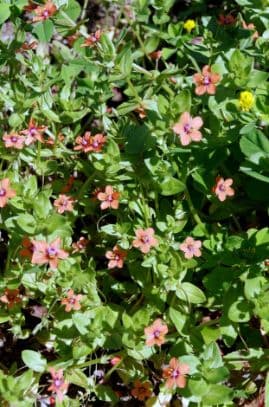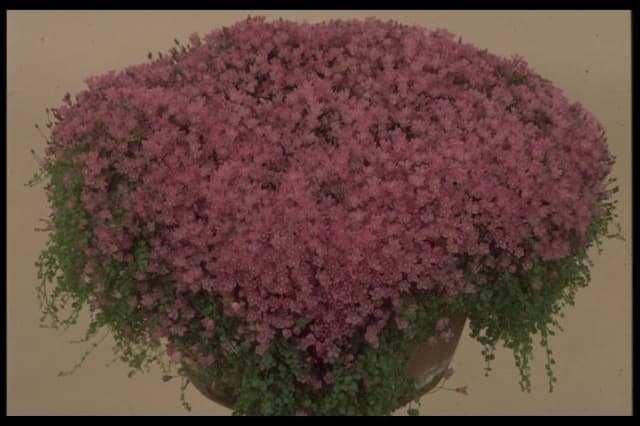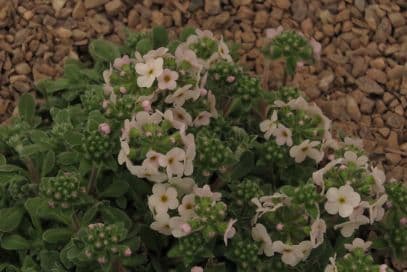Auricula Primula auricula 'Minley' (Au/s)

ABOUT
The Primula auricula 'Minley', commonly known as the Auricula, showcases unique and captivating features that make it a favorite among garden enthusiasts. The appearance of this Auricula is characterized by its striking flowers, which possess a delightful charm. Each blossom is made up of a round or sometimes slightly heart-shaped structure, which can come in a range of colors from deep purples to pale yellows or even vibrant reds and oranges. The petals often have a velvety texture and may display contrasting colors in the form of delicate edging or a bold, eye-catching center, known as the eye, that adds depth and intricacy to its look. The leaves of the Auricula are generally thick and have a slightly fleshy feel to them, contributing to the plant's overall robustness. They are typically a deep green color, which may sometimes take on a powdery or almost dusty appearance due to a fine covering of farina, a white, flour-like substance that coats the leaves and stems. This dusting adds a silvery sheen to the foliage and is a distinctive trait of certain Auriculas such as the 'Minley'. Arranged in a rosette formation at the base of the plant, the leaves form an attractive backdrop for the flowers which rise above them on sturdy stems. The overall appearance of the plant is one that exudes both a rustic charm and a sophisticated elegance, making it a delightful addition to various garden settings, from rock gardens to alpine displays or even as a part of a container garden collection.
About this plant
 Names
NamesFamily
Primulaceae.
Synonyms
Bear's Ear, Mountain Cowslip, Auricula.
Common names
Primula auricula 'Minley' (Au/s).
 Toxicity
ToxicityTo humans
The plant known as auricula is not considered highly toxic to humans. However, like other members of the Primula genus, it may contain compounds that can cause mild irritation or an allergic reaction upon contact with the skin or ingestion. If ingested, symptoms of auricula poisoning might include nausea, vomiting, or diarrhea. Although severe toxicity is rare, it is advisable to avoid consuming any part of the plant and to wash hands after handling it, especially if you have sensitive skin.
To pets
Auricula has a similar level of toxicity to pets as it does to humans, which is generally considered low. However, if pets consume parts of the plant, they might experience mild gastrointestinal upset, including symptoms such as drooling, vomiting, or diarrhea. It is advisable to keep an eye on pets and prevent them from ingesting the plant, but severe poisoning is unlikely. If your pet exhibits signs of distress after consuming auricula, it is best to consult a veterinarian.
 Characteristics
CharacteristicsLife cycle
Perennials
Foliage type
Evergreen
Color of leaves
Green
Flower color
Varies
Height
6 inches (15 cm)
Spread
6 inches (15 cm)
Plant type
Herb
Hardiness zones
5
Native area
Europe
Benefits
 General Benefits
General Benefits```html
- Ornamental Appeal: Primula auricula 'Minley' adds charm to gardens with its vibrant, attractive flowers and unique foliage.
- Low Maintenance: Requires minimal care once established, making it a good choice for gardeners of all levels.
- Compact Growth: Its small size allows it to fit well in rock gardens, containers, or small spaces.
- Long Blooming Season: Offers extended periods of bloom in the right conditions, adding lasting color to the garden.
- Attracts Pollinators: Flowers can attract bees, butterflies, and other beneficial insects, supporting local ecosystems.
- Drought Tolerant: Once established, it can tolerate periods of low water, contributing to water conservation efforts.
- Habitat Enrichment: Can provide shelter and food for small wildlife, such as insects and birds.
- Seasonal Interest: Provides a splash of color in early spring when many other plants are not yet in bloom.
- Non-Invasive: Typically does not spread aggressively, making it a good neighbor to other plants in the garden.
 Medical Properties
Medical Properties- This plant is not used for medical purposes.
 Air-purifying Qualities
Air-purifying QualitiesThis plant is not specifically known for air purifying qualities.
 Other Uses
Other Uses- The leaves of the auricula can be used as a natural dye for fabrics, providing a range of yellow to green hues depending on the mordant used.
- Auricula flowers are sometimes used in potpourri due to their fragrance, contributing a subtle scent to the mixture.
- Pressed auricula flowers can be incorporated into handmade paper, providing a decorative element for bespoke crafts and stationary.
- The blossoms are edible and can be used to add a splash of color to salads, desserts, or as a garnish for cocktails and drinks.
- In some traditions, auricula plants are given as a symbol of good luck and fortune, making them a thoughtful gift for new homeowners or gardeners.
- Auricula displays, particularly in auricula theatres, can be a unique horticultural hobby, combining gardening with artistic presentation.
- The patterned leaves and flowers can be used in nature photography as subjects for macro photography, capturing the intricate details.
- Flower enthusiasts may use the auricula as inspiration for botanical illustration, capturing the unique shapes and colors through art.
- The plant can play a role in sensory gardens, with its varied textures and colors providing visual and tactile stimuli.
- Auricula blooms can be used as a natural confetti for celebrations, offering an environmentally friendly alternative to synthetic confetti.
Interesting Facts
 Feng Shui
Feng ShuiThe Auricula is not used in Feng Shui practice.
 Zodiac Sign Compitability
Zodiac Sign CompitabilityThe Auricula is not used in astrology practice.
 Plant Symbolism
Plant Symbolism- Admiration: The Primula auricula, commonly known as Auricula or Bear's Ear, is often associated with admiration due to its unique and bold appearance.
- Precision and uniqueness: The 'Minley' variety, with its distinct hue and pattern, evokes a sense of individuality and meticulous beauty, symbolizing the value of being one of a kind.
- Courage and daring: Auriculas were historically celebrated by florists and enthusiasts who braved the elements to collect them from mountainous regions, which translates symbolically into the traits of bravery and adventure.
- Delicacy: The finely detailed flowers of the Auricula signify a sense of tenderness and finesse, reflecting delicate emotions or situations.
 Water
WaterBear's ear auricula should be watered thoroughly, allowing the top inch of soil to dry out before the next watering. Typically, this means watering once a week, but this can vary based on factors like temperature and humidity. During the active growing season in spring and summer, they may require water more frequently. Use lukewarm water, and carefully pour directly onto the soil, avoiding the leaves and flowers, with about 8-16 ounces for smaller pots or up to 1 gallon for larger containers, depending on the size of the plant and the pot.
 Light
LightBear's ear auricula thrives best in bright, indirect light. Direct sunlight can scorch its leaves, so it's best placed in a spot where it can receive filtered light, such as near a north-facing window or a shaded southern window. A little morning sun is acceptable but avoid hot midday rays that could cause damage.
 Temperature
TemperatureBear's ear auricula prefers cooler temperatures, generally between 50°F and 75°F. It can survive temperatures as low as 40°F but should be protected from frost. Extreme heat above 80°F can stress the plant, so it's best to provide a cooler environment for optimal growth.
 Pruning
PruningBear's ear auricula benefits from pruning to remove dead or yellowing leaves and spent flowers, which encourages new growth and blooming. Pruning is best done after flowering, typically in late spring or early summer. Cut back the foliage by about a third, using clean, sharp scissors or pruning shears, to maintain a compact and healthy plant.
 Cleaning
CleaningAs needed
 Soil
SoilBear's Ear, also known as Primula auricula 'Minley', thrives in well-draining, slightly gritty compost with a pH range between 6.0 and 7.0. An ideal soil mix consists of one part loam, one part peat-free compost, and one part grit or perlite.
 Repotting
RepottingBear's Ear should be repotted every year or two to refresh the soil, ideally in the late summer or early autumn after flowering has ceased.
 Humidity & Misting
Humidity & MistingBear's Ear prefers a humidity level of around 50%, avoiding both overly dry air which can stress the plant and excessively high humidity that may promote rot.
 Suitable locations
Suitable locationsIndoor
Place Bear's Ear in bright, indirect light with well-draining soil indoors.
Outdoor
For outdoor Bear's Ear, choose a sheltered spot with morning sun and loose soil.
Hardiness zone
4-8 USDA
 Life cycle
Life cycleThe common name for Primula auricula 'Minley' (Au/s) is Auricula Primrose. The life cycle of the Auricula Primrose begins with seed germination, typically in a cool and moist environment. After sprouting, the seedlings grow into vegetative plants with a rosette of leaves, during which root establishment and foliage development occur. The Auricula Primrose then enters the flowering stage, producing vibrant flowers that may be pollinated by insects, leading to seed set. Following pollination, seeds develop and are eventually dispersed to start a new generation. The plant may enter a period of dormancy during adverse conditions but resumes growth with the onset of favorable seasons.
 Propogation
PropogationPropogation time
Spring-Early Summer
Propogation: The Primula auricula, also known as Bear's Ear, is most commonly propagated through division, which is best done immediately after the plant finishes flowering in late spring to early summer. To propagate by division, carefully dig up the plant, ensuring to get as much of the root system as possible. Gently separate the plant into smaller clumps, making sure each new section has a portion of the roots. Replant the divisions at the same depth they were originally growing, spacing them about 6 to 12 inches (15 to 30 centimeters) apart to give them room to grow. Water the new divisions well to help establish them. Division helps to rejuvenate older plants and produce more blooms the following season.









